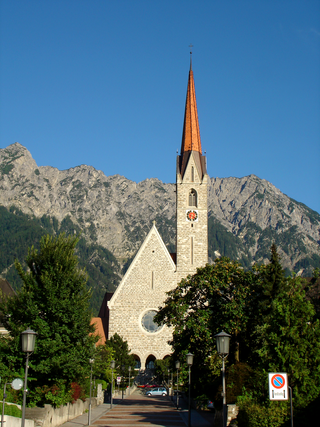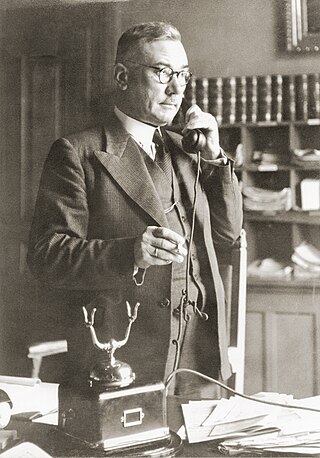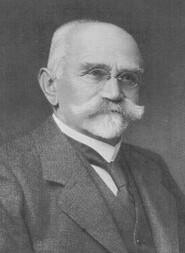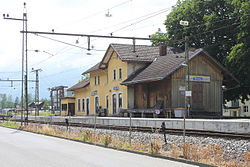
Political identity came to the territory now occupied by the Principality of Liechtenstein in 814, with the formation of the subcountry of Lower Rhætia. Liechtenstein's borders have remained unchanged since 1434, when the Rhine established the border between the Holy Roman Empire and the Swiss cantons.

Eschen is a municipality in the north of Liechtenstein. It has a population of 4,466, and covers an area of 10.3 square kilometres. It is the fourth-largest town in Liechtenstein by population.

Schaan is the largest municipality of Liechtenstein by population. It is located to the north of Vaduz, the capital, in the central part of the country. As of 2019 it has a population of 6,039, making it the most populous administrative district in Liechtenstein. Representing an important traffic hub and industrial location of the country, Schaan covers an area of 26.8 km2 (10.3 sq mi), including mountains and forest. It is a municipality within the electoral district of Oberland in the Principality of Liechtenstein. Schaan contains four enclaves: Brunnenegg, Gritsch, Guschg, and Plankner Neugrütt.

Planken is a municipality in Oberland, Liechtenstein. It has four exclaves, two enclaves and a population of 473. Thus by population it is the smallest municipality of Liechtenstein.

Gamprin is a municipality of Liechtenstein, on the Rhine on the border with the municipality of Sennwald, in Switzerland. It had 1,690 inhabitants in 2019. The municipality contains the village of Bendern and scattered hamlets and the Liechtenstein Institute and LGT Group.

Liechtenstein's one railway line is operated by Austrian Federal Railways. As such, it represents an exception to the more usual Liechtenstein practice of cooperating closely with Switzerland, as in the case of the principality's use of the Swiss franc as its currency and its membership of a common customs area with its western neighbour. The rail line carries international services between Austria and Switzerland, most of which run non-stop through the principality. Only one local train service stops at three of the four stations located in Liechtenstein. The S2 runs 11 times in each direction a day on Workdays connecting Buchs SG to Feldkirch. In addition, there are 9 long-distance international trains that pass through Liechtenstein. The line is also used to transport freight.

Schaanwald is a village of Liechtenstein, located in the municipality of Mauren.

This is a survey of the postage stamps and postal history of Liechtenstein.

Schaan-Vaduz is one of the four train stations serving Liechtenstein, located in the town of Schaan, 3.5 km (2.2 mi) from Vaduz. It is owned by the Austrian Federal Railways (ÖBB). The station is served by 22 trains per day, 11 in each direction between Switzerland and Austria.

Franz Josef Hoop was a diplomat and political figure from Liechtenstein who served as Prime Minister of Liechtenstein from 1928 to 1945.

Nendeln is one of the four railway stations serving Liechtenstein. It is located in the village of Nendeln, in Eschen municipality. The station is served by eighteen trains per day, nine in each direction between Switzerland and Austria.

Schaanwald is one of four railway stations in Liechtenstein. It is located in the village of Schaanwald, in Mauren municipality. The station is currently disused and not served by any train service.

Buchs SG railway station is a railway station in Buchs, in the Swiss canton of St. Gallen. It is an intermediate stop on the Chur–Rorschach line and western terminus of the Feldkirch–Buchs line to Austria and Liechtenstein. It is served by local and long-distance trains. As the station is located just north of the crossing of the Rhine between Switzerland and Liechtenstein, long-distance trains traveling between Zürich and points east must reverse direction.

Germany–Liechtenstein relations are the diplomatic relations between Germany and Liechtenstein. Both states are members of the Organization for Security and Cooperation in Europe (OSCE), the Council of Europe and the European Economic Area.

Georg Malin is a Liechtensteiner artist, sculptor, historian and politician. Between 1974 and 1978, Malin served as member of the governing council in the Liechtenstein government, for the Progressive Citizens Party (FBP). He previously served as a member of the Landtag of Liechtenstein from 1966 to 1974, where he was also a member on the parliamentary delegation to the European Council.

Ludwig Marxer was an advocate and political figure from Liechtenstein who served as the Deputy Prime Minister of Liechtenstein from 1928 to 1933.
The 1939 Liechtenstein putsch, also known as the Annexation putsch was an unsuccessful coup d'état by the German National Movement in Liechtenstein designed to provoke Liechtenstein's annexation into Nazi Germany.

Albert Schädler was a physician, historian and political figure from Liechtenstein who served as the President of the Landtag of Liechtenstein 1882 to 1885 and again from 1890 to 1918.

Karl Schädler was a physician and political figure from Liechtenstein who served as the President of the Landtag of Liechtenstein from 1862 to 1870.
Gebhard Schädler was a surgeon from Liechtenstein.


















